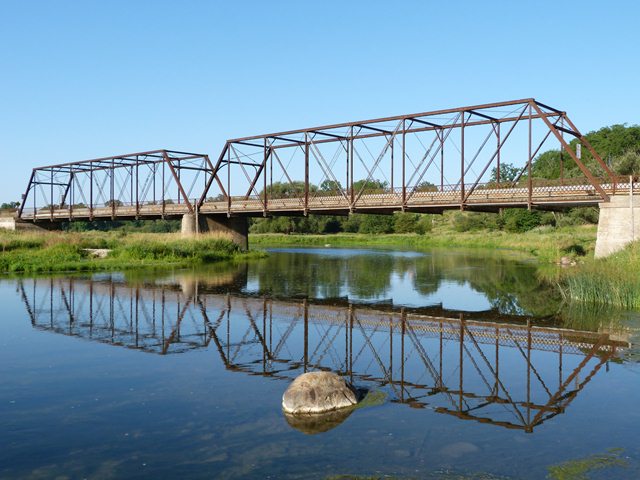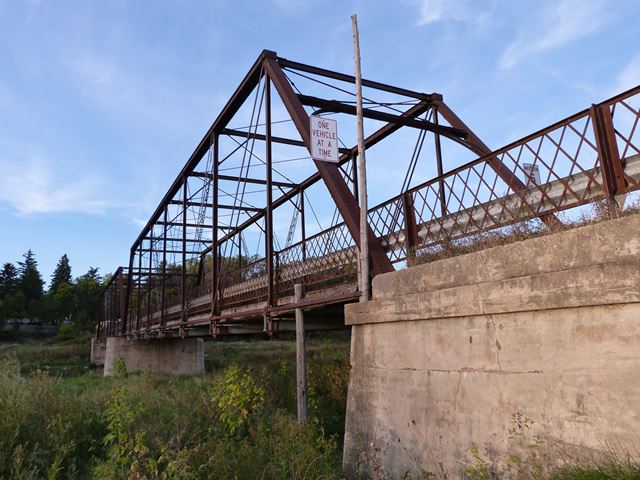We Recommend:
Bach Steel - Experts at historic truss bridge restoration.
BridgeHunter.com Phase 1 is released to the public! - Visit Now
Conestogo Bridge

Primary Photographer(s): Nathan Holth and Rick McOmber
Bridge Documented: July 21, 2012
Conestogo: Waterloo Region, Ontario: Canada
1886 By Builder/Contractor: Hamilton Bridge Company of Hamilton, Ontario
1926
130.6 Feet (39.8 Meters)
261.0 Feet (79.6 Meters)
18 Feet (5.49 Meters)
2 Main Span(s)
Not Applicable

View Information About HSR Ratings
Bridge Documentation

This bridge is among the oldest metal truss bridges remaining in Canada. Constructed in 1886 by the Hamilton Bridge Company, which at the time was known as the Hamilton Bridge and Tool Company, this bridge displays a number of unusual construction details.
In particular, some of the diagonal members on the pin-connected bridge are not typical eyebars, and instead are bars that split into an unusual two-prong design that includes holes at the end to accept the pin. These appear to have been designed for diagonals in those panels where there was not to be a pair of diagonal members, but a single diagonal only. The split design allows the u-bolt hanger to fit on the pin in between the prongs, while the prongs fit in between the vertical members. On other diagonals where there are a pair of more traditional loop-forged eyebars, the eyebars are positioned on both sides of the vertical member on the pin.
Another unusual detail is the excessive use of eyebar (or eye rod) with dedicated pin connections for the bracing of this bridge, including within the portal bracing, where eye rods (complete with turnbuckles) connect to pins on the portal bracing.
The top chord and end posts of the bridge are not designed to neatly meet together smoothly, and instead the top chord has the appearance of a box beam simply resting on the end posts. The ends of the top chord end abruptly after the end post. The ends of the top chord are covered up by builder plaques. This technique is generally found only on earlier truss bridges, like the Conestogo Bridge.
The bridge's historically significant trusses overall retain good historic integrity. The only substantial alteration appears to be the addition of post-tensioning cables to some diagonal members. Because these cables are additions, and did not remove the original diagonal members, they are considered a minor alteration. There is currently no paint on the bridge to protect the bridge from future deterioration. Currently, the bridge is in good condition for its age, and any deterioration noted on the bridge could easily be corrected as part of a comprehensive rehabilitation that would repair, blast clean, and repaint the bridge, preparing it for another century of reliable service.
An issue found in the heritage inventory discussion was the statement that "The original Conestogo Bridge spanning the Conestoga River was built in 1886. The current Conestogo Bridge was built in 1928." This statement appears to be incorrect. While the substructure (piers and abutments) may have been constructed, the truss superstructure, which includes plaques with the date 1886 on them and also stylistically dates to the 1880s based on its details is clearly not a 1928 structure. The bridge undoubtedly dates to 1886.
In assessing the heritage significance of bridges in the Waterloo Region, a scoring system outlined in the 1991 Ontario Heritage Bridge Program developed by the Ministry of Transportation and the Ministry of Culture was employed. In general, this rating system works quite well. It evaluates most of the aspects of a heritage bridge that give it value, such as historic integrity, rarity of design, aesthetic value, function as a community gateway or landmark, etc. However, it occasionally does display some flaws. The Conestogo Bridge is perhaps the best example. Constructed in 1886, this bridge is among the oldest metal bridges remaining in all of Canada. The Ontario Heritage Bridge Program rating does not take into consideration the national significance of the bridge. Additionally, the two-span bridge is a rare example of a multi-span truss bridge. Longer structures indicate a greater engineering achievement, and they tend to be less common than shorter examples. Also, while the Ontario Heritage Bridge Program rating system does give points for bridges with a unique overall design, it does not assign points to bridges with innovative or distinctive details. The Conestogo Bridge displays several extremely unique details such as the heavy use of pin connections in the bracing, and the use of an unusual substitute for traditional eyebars. These details may be the only surviving examples in Ontario. While the Conestogo Bridge did score as a heritage bridge of moderate significance at 60 points under the Ontario Heritage Bridge Program rating system, the bridge did not end up on the top ten heritage bridges list for the Waterloo Region. This fact fails to convey the high level of both local and national heritage significance conveyed by this bridge.
In 2013, the Conestogo Bridge made a brief appearance in a 5-Hour Energy television advertisement. A screenshot from the advertisement showing the bridge is below. Bridges with heritage value seem to appear in advertisements frequently, disproportionately in comparison to modern bridges, especially given the comparative rarity of bridges with heritage value. It is the opinion of HistoricBridges.org that this is not coincidence and indicates that these beautiful, culture-rich bridges make advertisements more interesting and/or appealing to viewers.
Above: Screenshot from 5-Hour Energy Advertisement.
Information and Findings From Waterloo Region Heritage Bridge InventoryWaterloo Region Assigned Heritage Ratings: Overall Score: 60. (Heritage Bridge scores range from 50 up to generally 78) View Heritage Bridge Inventory Data Sheets |
![]()
Photo Galleries and Videos: Conestogo Bridge
Bridge Photo-Documentation
Original / Full Size PhotosA collection of overview and detail photos. This gallery offers photos in the highest available resolution and file size in a touch-friendly popup viewer.
Alternatively, Browse Without Using Viewer
![]()
Bridge Photo-Documentation
Mobile Optimized PhotosA collection of overview and detail photos. This gallery features data-friendly, fast-loading photos in a touch-friendly popup viewer.
Alternatively, Browse Without Using Viewer
![]()
Southbound Crossing
Full Motion VideoStreaming video of the bridge. Also includes a higher quality downloadable video for greater clarity or offline viewing.
![]()
Northbound Crossing
Full Motion VideoStreaming video of the bridge. Also includes a higher quality downloadable video for greater clarity or offline viewing.
![]()
Additional Unorganized Photos
Original / Full Size PhotosA supplemental collection of photos that are from additional visit(s) to the bridge and have not been organized or captioned. This gallery offers photos in the highest available resolution and file size in a touch-friendly popup viewer.
Alternatively, Browse Without Using Viewer
![]()
Additional Unorganized Photos
Mobile Optimized PhotosA supplemental collection of photos that are from additional visit(s) to the bridge and have not been organized or captioned. This gallery features data-friendly, fast-loading photos in a touch-friendly popup viewer.
Alternatively, Browse Without Using Viewer
![]()
Maps and Links: Conestogo Bridge
Coordinates (Latitude, Longitude):
Search For Additional Bridge Listings:
Additional Maps:
Google Streetview (If Available)
GeoHack (Additional Links and Coordinates)
Apple Maps (Via DuckDuckGo Search)
Apple Maps (Apple devices only)
Android: Open Location In Your Map or GPS App
Flickr Gallery (Find Nearby Photos)
Wikimedia Commons (Find Nearby Photos)
Directions Via Sygic For Android
Directions Via Sygic For iOS and Android Dolphin Browser




